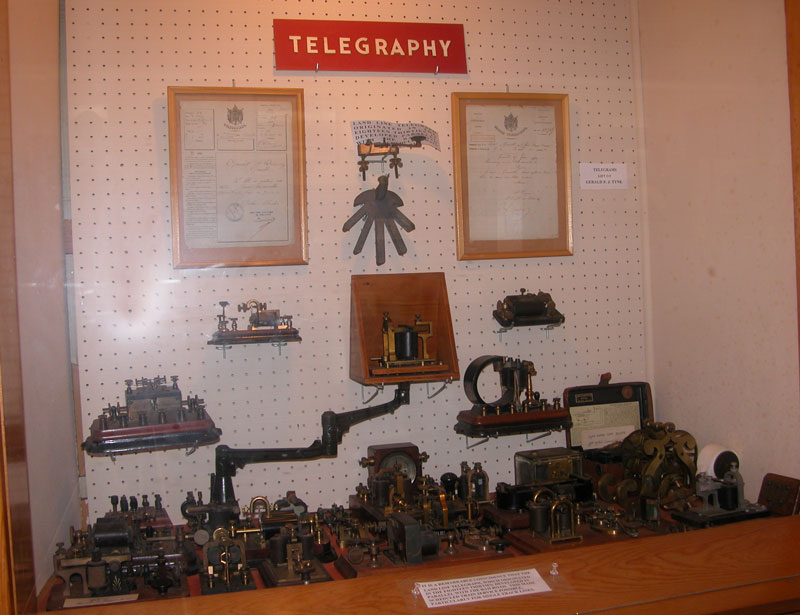There’s a very early telegraph register here, the one with the curlicues. There’s a clockwork motor that winds a tape. A pen marks the dots and dashes on the paper, and then the operator reads it afterwards.
If you look down here, you see the little miniature set on the small mahogany board. When they celebrated Morse’s fiftieth anniversary, they had a big banquet in New York, and all of the important people in industry were at the banquet, particularly the people in the telegraph business. Each place setting at the head table had one of those little miniature sets. They were wired under the linen tablecloth. The whole length of the table was on an open circuit so that anybody could talk to anybody up and down the table. And the interesting thing to us today is that the Morse Code was pretty much universally understood by people in business, because they would hear it chattering away in offices all the time, and they decided it would be better to learn it than to just listen to the noise. As a consequence, these big shots were able to talk to each other up and down the table.
The “Crow’s Foot”, hanging on the pegboard, is from the bottom of a gravity cell battery. Copper sulfate is the electrolyte. The virtue of this type of battery was that it could run on closed circuit for a long time without discharging. It was a reliable source of juice
Fred – “But didn’t they keep a continuous circuit going?”
Yes, particularly in the case of railroads. The whole railroad would be looped together from one end to the other. And you’ll notice, if you look at these keys, you see a little lever switch just to the right of the key handle? That closes the circuit on this particular set, so the signal would go right through it, on to the next station, down through the other line, so, it was never interrupted by breaking the circuit. The gravity cell needed a continuous current to prevent the two solutions from mixing.
Fred – “Now, I remember you told us before that the telegraph really paralleled the expansion of the railroads, or maybe the railroads paralleled the expansion of the telegraph.”
Yes, it was the most fortunate thing that the development of the telegraph and the railroad were simultaneous. They developed together, and one supported the other, particularly when they had one track and they had trains going both ways. And, of course, in the early days, one track was the rule. It cost money to put in a second track.
Fred – “What is that one in the back with the needle?”
Oh, that’s a galvanometer for testing. The technician would use that to check the circuit.
Text from the transcript of a tour of New England Wireless & Steam Museum’s Wireless Building given by Robert W. Merriam on a winter day in 2012. Transcription by Craig H. Moody, K1CHM. Edited by Fred Jaggi.
